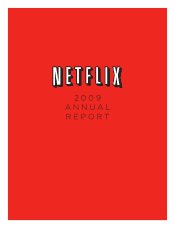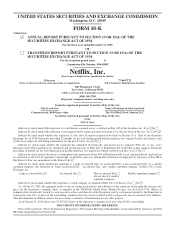NetFlix 2009 Annual Report Download - page 8
Download and view the complete annual report
Please find page 8 of the 2009 NetFlix annual report below. You can navigate through the pages in the report by either clicking on the pages listed below, or by using the keyword search tool below to find specific information within the annual report.our consumer electronics partners to generate new subscribers for our service. These programs encourage
consumers to subscribe to our service and may include a free trial period. At the end of the free trial period,
subscribers are automatically enrolled as paying subscribers, unless they cancel their subscription. All paying
subscribers are billed monthly in advance. We believe that our paid marketing efforts are significantly enhanced
by the benefits of word-of-mouth advertising, our subscriber referrals and our active public relations programs.
We use our proprietary recommendation and merchandising technology to determine which titles are
presented to a subscriber. In doing so, we believe we provide our subscribers with a quick and personalized way
to find titles they are more likely to enjoy while also effectively managing our inventory utilization. Our
merchandising efforts are used throughout our web site and as part of the user interface on many Netflix Ready
Devices to determine which titles are displayed to subscribers, including the generation of lists of similar titles.
We believe our merchandising efforts create a powerful method for catalog browsing and efficient library
utilization.
We obtain content through direct purchases, revenue sharing agreements and license agreements with
studios, distributors and other suppliers. DVD content is typically obtained through direct purchases or revenue
sharing agreements. Streaming content is generally licensed for a fixed fee for the term of the license agreement.
We ship and receive DVDs throughout the United States and maintain a nationwide network of shipping
centers that allows us to provide fast delivery and return service to our subscribers. We also utilize third party
content delivery networks to help us efficiently stream movies and TV episodes in high volume to Netflix
subscribers over the Internet.
We are focused on growing our subscriber base and revenues and utilizing our proprietary recommendation
and merchandising technology to minimize variable and fixed operating costs within the framework of providing
a valuable and compelling user experience. Our technology is extensively employed to manage and integrate our
business, including our Web site interface, order processing, fulfillment operations and customer service. We
believe that our technology also allows us to maximize our library utilization and to run our fulfillment
operations in a flexible manner with minimal capital requirements.
We are organized in a single operating segment. We currently generate all our revenues in the United States,
although we plan to launch a limited international expansion with a streaming subscription service in 2010.
Substantially all our revenues are derived from monthly subscription fees. We have no long-lived assets outside
the United States.
Industry and competitive overview
We operate in the subscription segment of the in-home entertainment video market. In 2007, we expanded
our DVD-by-mail distribution model to include streaming content over the Internet. This hybrid distribution
model expands the consumer appeal of the Netflix subscription service beyond the traditional reach of the DVD
rental segment and offers subscribers a uniquely compelling selection of content, both streaming and DVD, for
one low monthly price. While the consumer appeal of this hybrid service has grown quickly, the market for
Internet delivered video content is still in its formative stages, and we expect competition to be intense.
Currently the market for Internet delivered video consists of three market segments: video-on-demand
(“VOD”), ad supported, and subscription. The VOD segment includes competitors like Amazon, Apple,
Blockbuster, Cinemanow and Microsoft. The ad supported segment includes competitors like Hulu and
YouTube. Currently, Netflix is the primary provider in the subscription segment, but we expect direct and
indirect competition to emerge and continue to grow as the consumer appeal for Internet delivery of video
continues to expand.
The market for in-home entertainment video is intensely competitive and subject to rapid change. Many
consumers maintain simultaneous relationships with multiple in-home entertainment video providers and can
2





















